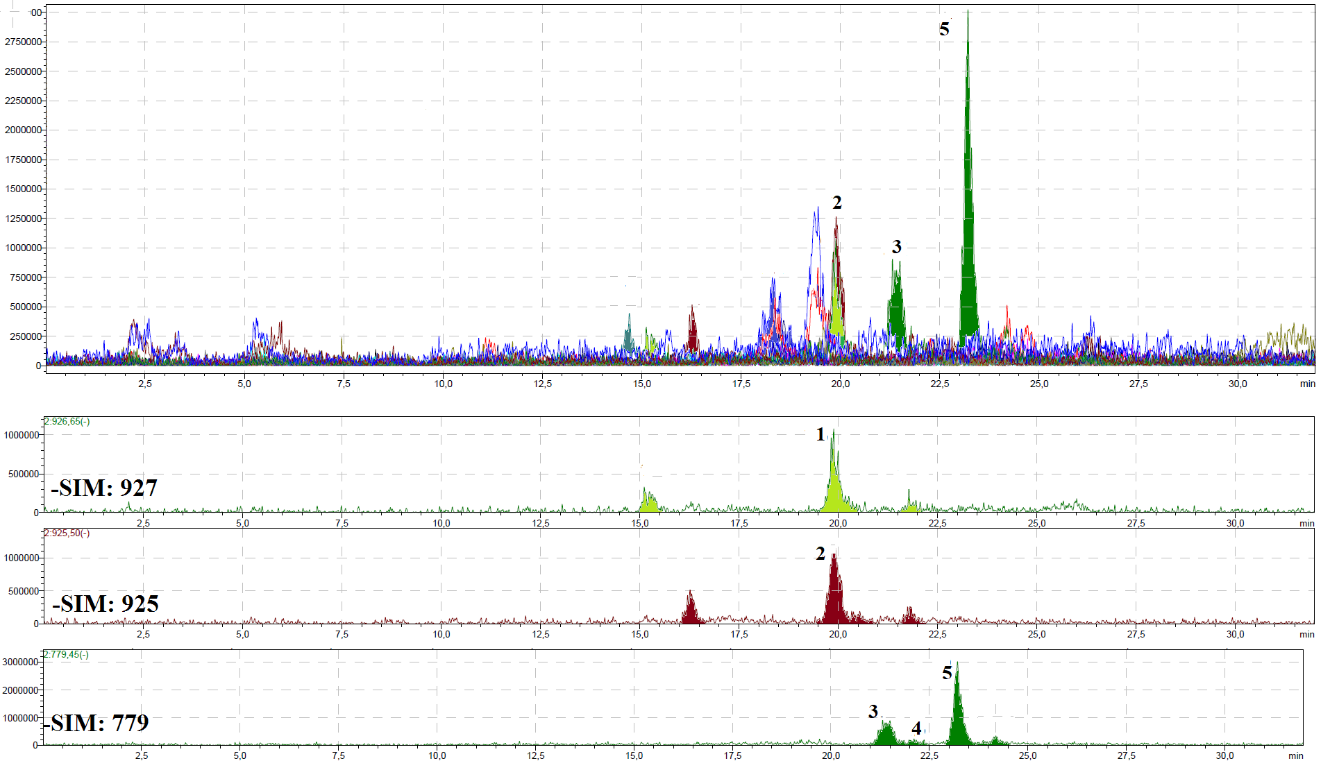TRITERPENE COMPOUNDS OF THE ABOVE GROUND ORGANS OF THE BUPLEURUM SCORZONERIFOLIUM WILLD. OF THE BAIKAL REGION FLORA
UDC 615.31:[582.794.1:547.918](571.53)
Abstract
Representatives of the genus Bupleurum L. in the composition of biologically active substances accumulate triterpene compounds (derivatives of α-amyrin and β-amyrin). Triterpene glycosides isolated from plants of the genus Bupleurum are called saikosaponinov, buplevrozidy, skorzonerozidy. Plants of the genus Bupleurum in the underground organs accumulate triterpene compounds in an amount of from 1 to 7%. Triterpene compounds of plants of the genus Bupleurum possess a hepatoprotective, antiviral, cytostatic effect. We have studied the triterpene compounds of the aerial organs of Bupleurum scorzonerifolium Willd. The material for the study was collected on the territory of the Irkutsk region (Russia). Isolation of triterpene compounds was performed with 70% ethyl alcohol. The compounds were identified by liquid chromatography with mass spectrometry and diode-matrix detection (UPLC-DAD-ESI-MS/MS). According to the results of the analysis, the content of 5 triterpene compounds was established: saikosaponinov A, B2, C, D, F. The isolated compounds are structurally derived from oleanan, in which glycosidation is observed at the C-3 position with α-L-rhinose, β-D-glucose and β-D-fucose. The spectrophotometric method determined the quantitative content of the amount of triterpene compounds in the above-ground organs of B. scorzonerifolium at different phases of the vegetation of the plant, by organs (in flowers, leaves, stalks), and also depending on the place of growth. It has been established that the maximum amount of the amount of triterpene compounds accumulates in the aboveground organs of B. scorzonerifolium during the flowering phase – 1.54±0.05%; the highest content of this group of compounds is noted in flowers – 1.70±0.06%; most of all, this group of compounds is collected by samples collected in the Ust-Horde Buryat District (1.96±0.06%). The aboveground organs of B. scorzonerifolium can be used as a source of triterpene compounds, the highest content of which is noted in the flowering phase. The study of triterpene compounds in the aboveground organs of B. scorzonerifolium was carried out for the first time.
Downloads
Metrics
References
Ashour M.L., Wink M. Journal of Pharmacy and Pharmacology, 2011, vol. 63, pp. 305–321. DOI: 10.1111/j.2042-7158.2010.01170.x.
Pan S.L. Bupleurum species: Scientific Evaluation and Clinical Applications. CRC, 2006, 272 p. DOI: 10.1201/9781420009071.
Yoshikawa M., Murakami T., Hirano K. Tetrahedron Letters, 1997, vol. 38 (42), pp. 7395–7398.
Huang H.Q. J. Sep. Sci., 2008, vol. 31, pp. 3190–3201. DOI: 10.1002/jssc.200800120.
Pan S.L., Wang Z.H., Hong X.K., Lin D.H. J. Jpn. Med. Bot., 2000, vol. 23, pp. 40–44.
Chiang L.C. Planta Med., 2003, vol. 69, pp. 705–709. DOI: 10.1055/s-2003-42797.
Abe H. Planta Med., 1980, vol. 40, pp. 366–372.
Tan L., Zhao Y.Y., Wang B., Zhang R.Y. Phitochemistry, 1999, vol. 50, pp. 139–142.
Tykheyev Zh.A., Taraskin V.V., Dylenova Ye.P. Ekologobezopasnyye i resursosberegayushchiye tekhnologii i materi-aly. [Ecologically safe and resource-saving technologies and materials]. Ulan-Ude, 2017, pp. 284–286. (in Russ.).
Yamamoto M. Arzneimittelforschung, 1975, vol. 25, pp. 1021–1023.
Cui L.H. Chemico-biological interactions, 2019, vol. 300, pp. 18–26. DOI: 10.1016/j.cbi.2019.01.005.
Feng Y. Medicinal Chemistry Research, 2019, pp. 1–7.
Sun P. Mini reviews in medicinal chemistry, 2019, vol. 19, no. 1, pp. 34–55. DOI: 10.2174/1871520618666180628155931.
Wang Y.L., He S.X., Luo, J.Y. J. Integrat. Med., 2006, vol. 4(1), pp. 98–100.
Pistelli L., Cammilli A., Manunta A., Marsili A. Phytochemistry, 1993, vol. 33, pp. 1537–1539.
Park K.H. Phytother Res., 2002, vol. 16, pp. 359–363. DOI: 10.1002/ptr.903.
Chang J.S. Am. J. Chin. Med., 2007, vol. 35, pp. 341–351.
Gu L.Y. J. BUON., 2015, vol. 20, no. 5, pp. 1341–1349.
Murav'yev I.A., Shatilo V.V., Semenchenko V.F. Khimiya prirodnykh soyedineniy, 1972, no. 6, pp. 738–740. (in Russ.).
Petukhova S.A. Farmakognosticheskoye issledovaniye volodushki kozeletselistnoy (Bupleurum scorzonerifolium Willd.) i razrabotka na yeye osnove ekstrakta sukhogo: avtoref. dis. … kand. farm. nauk. [Pharmacognostic study of goat-cellulose hairwort (Bupleurum scorzonerifolium Willd.) And development of dry extract based on it: abstract. dis. ... cand. farm. sciences]. Ulan-Ude, 2018, 24 p. (in Russ.).
Ishii H. et al. Chemical and Pharmaceutical Bulletin, 1980, vol. 28, no. 8, pp. 2367–2373. DOI: 10.1248/cpb.28.2367.
Liang Z. et al. Acta Pharmaceutica Sinica B, 2013, vol. 3, no. 3, pp. 193–204. DOI: 10.1016/j.apsb.2013.04.002.

Copyright (c) 2019 Khimiia rastitel'nogo syr'ia (Chemistry of plant raw material)

This work is licensed under a Creative Commons Attribution 4.0 International License.

This work is licensed under a Creative Commons Attribution 4.0 International License.
The authors, which are published in this journal, agree to the following conditions:
1. Authors retain the copyright to the work and transfer to the journal the right of the first publication along with the work, at the same time licensing it under the terms of the Creative Commons Attribution License, which allows others to distribute this work with the obligatory indication of the authorship of this work and a link to the original publication in this journal .
2. The authors retain the right to enter into separate, additional contractual agreements for the non-exclusive distribution of the version of the work published by this journal (for example, to place it in the university depository or to publish it in a book), with reference to the original publication in this journal.
3. Authors are allowed to post their work on the Internet (for example, in a university repository or on their personal website) before and during the review process of this journal, as this may lead to a productive discussion, as well as more links to this published work.











